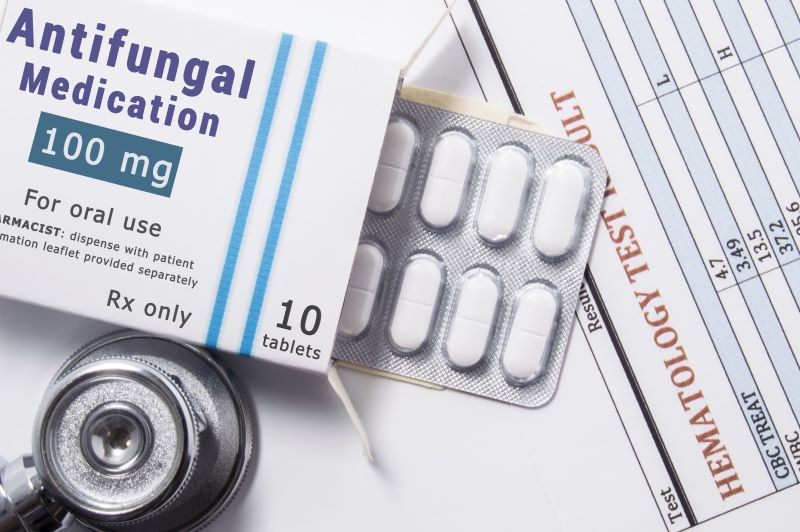What is Hyaluronic Acid? Hyaluronic Acid (HA) is a molecule that is found throughout our bodies in our fluids and…

 Skin
Skin
What Medication Is Used for Toenail Fungus
What is Toenail Fungus?
Fungal infections are skin diseases caused by a fungus. Different species of fungi can cause skin problems like rashes or bumps. One of the most common types of toenail fungus is Athlete’s foot (tinea pedis). The fungus that causes it is commonly found on damp surfaces like swimming pools or public showers. It appears as a blistered rash that causes stinging and itching between the toes or sides of the feet.
Most symptoms are common when it comes to toenail fungus or nail fungal infections, regardless of the type of bacteria. A painful, itchy rash will begin to grow around the toenail. The toenail will become yellowish and may have white spots, and the infected nail might become warped or cracked. Men are at a higher risk of developing toenail fungus. Additionally, individuals who smoke or have diabetes are also at a higher risk of contracting a foot fungus.
How is it Diagnosed?
When it comes to a diagnosis, your doctor will examine your fungal nails and likely take a sample by scraping or clipping some of the nail to send to the lab. This begs the question, “Is toenail fungus curable?” Once tested, your doctor will get the results of what the nail infection is and how they can treat it. Sometimes psoriasis can be mistaken as a fungal infection, so always be sure to get tested with your doctor.
How is it Treated?
To determine what medication is used for toenail fungus, seek medical advice from the professionals. When it comes to toenail fungus treatment, there are different medications that your doctor will recommend or prescribe you, depending on the type of nail fungus and the level of severity the toenail fungal infection has reached.
- Over-the-counter: There are a decent amount of OTC products that work to prevent nail fungus infection and further stop the growth of toenail fungus. There are topical gels and creams that can be applied to the area. Foot powders and sprays can also help stop the growth of the foot fungus before it gets deeper into the nail. These products are very useful in treating mild cases; however, they do not penetrate the cuticle or the actual infected nail. This is where prescription medication comes in.
- Oral medications: Oral medications are typically a doctor’s first choice to prescribe because they are proven to clear up the fungal nail infection more quickly than topical treatment drugs. The drugs work by helping new nails grow without the infection and replace the infected part of the nail. Oral medications like these are taken for six to twelve weeks. The most popular antifungal medication drugs used are Lamisil and Sporanox.
- Topical medications: Prescription topicals can also be prescribed if the toenail fungus infection isn’t too widespread but does not seem to be going away with over-the-counter drugs. Topical medications can come in the form of a cream or a medication nail polish. The topical medication cream should be applied to the affected nail after soaking the nail. The soaking allows the cream to seep through the skin and further into the fungal toenail to stop the spread of the fungus. The medicated nail polish is painted onto the nail and should be layered for about a week. After one week, you can wipe the layers clean and begin again.
- Surgery: In severe cases, your doctor might recommend surgery. If the fungal toenail infection is incredibly painful or severe, your doctor will remove the nail completely and apply the antifungal drug directly under the skin.
If you’re wondering, “Can a fungal nail infection spread?” We cover everything you need to know.
Home Remedies
Again, if the fungal infection is mild, there are some techniques you can use at home to help eliminate the toenail infection.
- Trim and thin: Continuously trim and thin your nails to reduce inflammation and pain. Then apply an OTC drug after you thin your nail so it can work more effectively.
- Footbath: Mixing warm water and hydrogen peroxide, vinegar, baking soda, and/or Epsom salt and letting your feet soak in this for 15-20 minutes has been proven effective to eliminate toenail fungus.
- Antifungal essential oil: Certain essential oils have antifungal properties that can help heal toenail fungus infection. Mix any of the following with olive oil and apply to the affected area: tea tree oil, clove oil, clary sage oil, jasmine oil, lavender oil, ylang-ylang oil, eucalyptus oil, cinnamon oil, lemon oil, or lemongrass oil.
Conclusion:
If you find yourself struggling to get rid of toenail fungus, you should contact your doctor. They will prescribe the right nail fungus treatment plan to help get rid of it. If you find yourself asking “what is the best cure for toenail fungus” or with any questions regarding toenail fungus, other fungal infections, or any skincare questions in general, feel free to reach out to your local Apotheco pharmacy today!
Sources
This blog is based on research and/or other scientific articles and is written by our experienced Chief Strategy Officer and Pharmacist, Ronak Desai. This blog is fact checked by our educated Pharmacist in Charge, Darshan Patel, who additionally runs our Apotheco Manhattan location.
Here at Apotheco Pharmacy Group, our goal is to provide the most up to date and accurate information on health and dermatology related topics. We do this to ensure our readers can make informed decisions based on factual content. All blogs undergo an extensive review process before posted.
This blog contains trusted sources. All sources are listed at the bottom of this article with hyperlinks that take you directly to the source.





